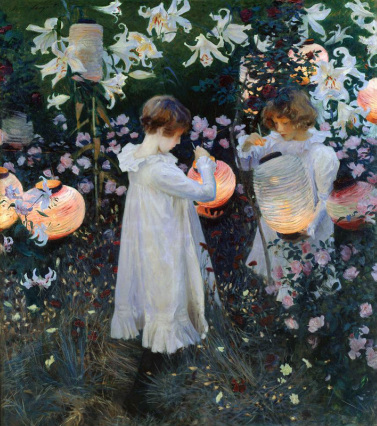 Poet, art critic and friend to John Singer Sargent, Edmund Gosse, wrote of Sargent's working style for this amazing painting, "...the easel, the canvas, the flowers, the demure little girls in their white dresses, before we began our daily afternoon lawn tennis, in which Sargent took his share. But at the exact moment, which of course came a minute or two earlier each evening, the game was stopped, and the painter was accompanied to the scene of this labours. Instantly, he took up his place at a distance from the canvas, and at a certain notation of the light ran forward over the lawn with the action of a wag-tail, planting at the same time, rapid dabs of paint on the picture, and then retiring again, only, with equal suddenness, to repeat the wag-tail action. All this occupied but two or three minutes, the light rapidly declining, and then, while he left the young ladies to remove his machinery, Sargent would join us again, so long as the twilight permitted, in a last turn at lawn tennis." (quoted in Evan Charteris' "John Sargent", pp.74-75). "Carnation, Lily, Lily, Rose" was painted by Sargent between August 1885 and October 1886. Sargent was inspired by the Chinese lanterns and lilies hanging from trees while on a boating trip on the Thames near Pangbourne with American artist Edwin Austin Abbey in the summer of 1885. This painting was one of the few he painted of figures outside, in the Impressionist style. He began the painting, which was originally entitled, "Garden Study" during a visit to Broadway, Worchester where he stayed with American painter and friend, Francis Davis Millet and his family. It was first conceived as a picture of a young girl lighting a lantern as the light of day around her faded into evening. As his original model, Sargent painted the Millet's daughter, Katharine. Dark haired Katharine was only five years old. He felt the her hair should be light in the painting, so he found a wig for her to wear. Soon after, he found Polly and and Dorothy Barnard, daughters of Alice and Fred Barnard. They were a bit older than Katharine Millet. They were seven and eleven, and had blonde hair. Painting "Carnation, Lily, Lily, Rose" (a title taken after the refrain of a popular song of the day "The Wreath" by composer Joseph Mazzinghi.), was at best a difficult undertaking as the children were wriggly and the light at that moment in evening when he painted was brief. He made sure his tools were at the ready as evening came when he posed his models for brief moments of painting. As summer ended and cooler weather approached, Sargent replaced the lilies with imitations. He was said to have, on several occasions, scraped the previous evening's paint off, starting anew during the next evening's session. He made the composition smaller and squarish by cutting two feet off the left side. The painting was purchased in 1887 for The Tate Gallery Britain, London. References: "John Singer Sargent", by Carter Ratcliff. Cross River Press. Ltd.; The Tate Britain. Studies for "Carnation, Lily, Lily, Rose".
5 Comments
10/7/2012 08:31:27 am
This has always been one of my favorite images. Thanks for bringing it back to me.
Reply
Jinny
10/8/2012 01:32:26 am
Interesting and informative article, Leslie. I learn so much from you.
Reply
Marilyn Mason "Mimi"
10/9/2012 06:37:37 am
How quickly time passes. Sergeant's painting is proof of his dedication. I love this painting and to be reminded that the first attempts are often just ones warm ups. Thanks for sharing Leslie.
Reply
12/23/2012 08:08:09 pm
I have seen many of you paintings but this painting is the impressionist style. I would like to see some more similar paintings.
Reply
Your comment will be posted after it is approved.
Leave a Reply. |
AuthorNicole Adkisson is the Director and principal instructor at the Oklahoma Academy of Classical Art. Thanks for reading - hope you enjoy! Archives
July 2020
Categories
All
You can subscribe to blog updates via email by submitting your email address in the space provided below.
|




 RSS Feed
RSS Feed
